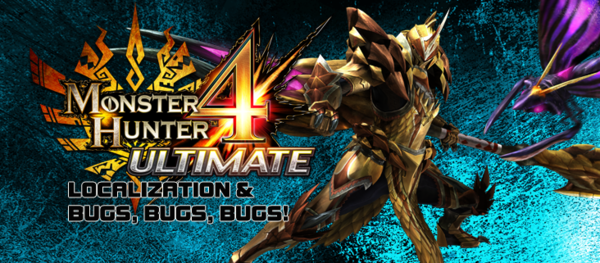
Monster Hunter 4 Ultimate: Localization & Bugs Bugs Bugs!
Jan 20, 2015 // Andrew Alfonso
Hello, everyone! Have you heard about Monster Hunter 4 Ultimate’s release date yet?! If not, you might want to check out Yuri’s post about it. The Monster Hunter Hype Train has just left the station, and is picking up some serious steam! CHOO-CHOO!
Today I thought we’d switch gears a bit and talk about one of the new weapons in Monster Hunter 4 Ultimate, the Insect Glaive. The Japanese name for the weapon is Souchuukon (æ“è’«æ£) , which roughly translates into “Control Insect Cane”, and it perfectly describes the function of the weapon. Well, in Japanese anyway. When Monster Hunter 4 made its debut at Tokyo Game Show 2012, we tentatively named it Neopteron Handler but were given permission to change it later on. I personally didn’t like the name too much because it’s too hard to pronounce and a little too long, considering the space restrictions we sometimes run into during localization.
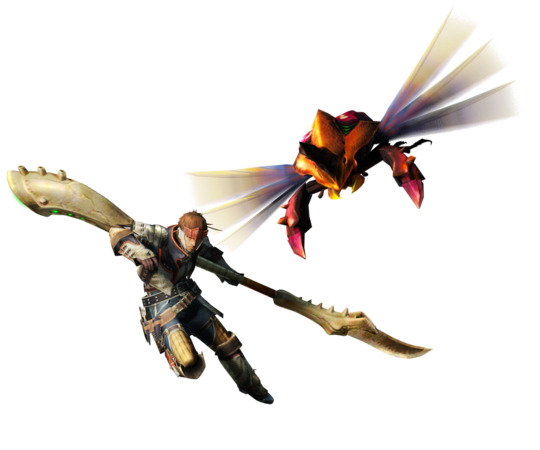
While you may look at Insect Glaive and think it wasn’t too difficult to come up with, we spent nearly two weeks discussing the term with the director Fujioka-san and lead designer Tokuda-san. First, Fujioka-san gave us a short list of concepts and images he wanted the weapon name to encompass.
- Absorption, suction (å¸åŽ)
- Enhancement, strengthening (強化)
- Artisan, falconer (åŒ /é·¹åŒ )
- Hunting (猟)
- Enhancing extract (強化エã‚ス)
- Organism (生体)
Now, Fujioka-san didn’t want one weapon name to have all of these concepts, but these were the building blocks for the Japanese name, so he wanted all of our ideas to be based on the same concepts. We came up with an exhaustive list of names, and unlike the monster names, we didn’t create the usual short list due to the sheer amount of ideas we had to cover. We actually had so many names that I had to short-list them for this blog!
- Swarmstaff: This was the overall favorite of the localization staff, and we thought it was a short but effective name to describe the weapon.
- Hunting Bug: For this we ditched the actual weapon part and opted to focus on the bug that accompanies the hunter.
- Leechstaff: Focuses on what the bug does for the hunter while keeping the weapon name intact.
- Pherocaster: This may be a strange one, but we were trying to describe how the hunter uses pheromones to command the bug during a quest.
- Augmentor Staff: Again, this was to focus on what the bug does for the hunter rather than what the hunter does with the bug.
In retrospect, I felt we went too crazy with the names and Fujioka-san told us as much; he wanted something simpler and more in line with the other weapon names. This was a valid criticism because the category names are quite grounded, and throwing in something like Swarmstaff or Pherocaster would stick out like Gravios in a pack of Ioprey. We submitted a couple of other names that were dialed down a notch, such as Bug Bo, Insect Staff, and Insect Glaive.
Insect Glaive was chosen due to the properties of the weapon – it’s capable of severing tails and doesn’t do blunt damage – and because there are more weapons that look like glaives than there are staffs.
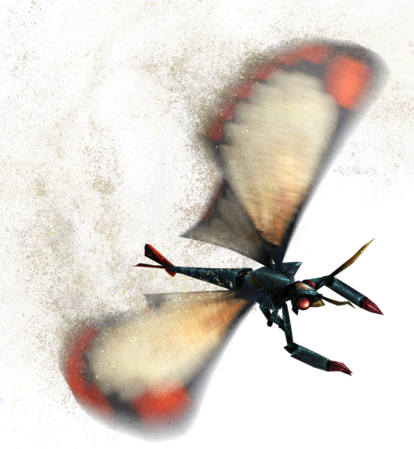
As for your friendly hunting bug, we only had one name for it, and that was Kinsect, a combination of Kinship and Insect. We thought it was the perfect name for the creature. It describes the symbiotic bond the bug has with the hunter, and rolls off the tongue really well.
Speaking of bugs, today I’ll talk about a pair of new insect-like creatures that make their debut in Monster Hunter 4 Ultimate .
Seltas, Seltas Queen
The first monster tandem in the series provides a unique twist to the hunt by having two monsters work together to take down the hunters. By itself, the male Seltas isn’t too much of a problem, but when big momma Seltas Queen shows up, things can go downhill quickly. The Seltas Queen can control the male Seltas and use him as a weapon, or he can climb on her back and act as a turret of sorts, firing projectiles while she rushes down the hunter. To make matters worse, the Seltas is actually strong enough to lift his female counterpart and crush reckless hunters.
We had a unique challenge facing us when we worked on these two monsters because they share the same general name in Japanese, which was a combination of the Hebrew word for iron and the scientific name for a species of scorpion. We also needed to express how this pair works together and what their roles are in the relationship; the Japanese names allude to a militaristic pairing, where the female acts as a commander-in-chief while the male is a grunt, working in the trenches.

We came up with Scorius as a base name for the pair, which is a combination of Scorpion and Sagittarius. We thought this would be good because the female has a stinger-like tail that she uses when attacking, while the male fires projectiles like an archer when attacking.
Another name we threw into the mix was Scarath, that, much like Scorius, tries to make ties to a scorpion, and also a scarab. The –ath suffix was added for consistency with the Monster Hunter world.
For the female monster, we had this image of a fierce queen going into battle with her loyal subjects, so we toyed with terms like Queen, Regent, Rhea (wife of Cronus in Greek mythology), and Duchess. Fujioka-san liked the simpler Queen tag so we settled on that very quickly. For the common name we sat down and talked with both Fujioka-san and Tokuda-san, and they asked if Seltas, the base Japanese name, would be something we could get behind.
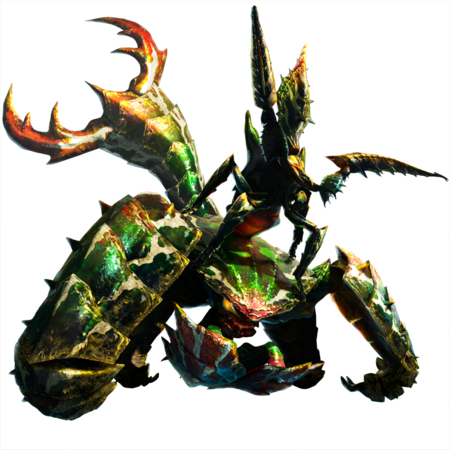
Going back to my first post on localization, about not having any sacred cows, it also applies to the stuff the translators come up with. We really thought that Scorius and Scarath were good names for these monsters, but we know better than to be married to our ideas. When Tokuda-san suggested Seltas as a candidate name, we thought it was actually a good idea. That part of the name is easy to say, plus it sounds like an insect, so we opted to go with that name instead of our own.
Desert Seltas, Desert Seltas Queen
The subspecies was yet another unique challenge because, compared to other monsters, the appearance of the pair changes quite a lot. For example, the male monster went from having a short, single horn to two gigantic horns, and his pincers are more suited for burrowing underground.
In the world of localization, space is god. Localizing from Japanese to English requires a certain amount of space and if you don’t have that, it gets really difficult to properly translate words. Japanese has an advantage because they can express so much through just one or two characters, whereas in English we have to write long phrases for the same thing. Don’t even get me started on the European languages. Oof.

So for the subspecies we had to keep the names short, because Seltas Queen was already pretty long by itself. The names aren’t too bad when we’re detailing the objectives of a quest, but they can be a nightmare to handle when it comes to material names. At any rate, we wanted to build on our ideas for the main species name, so we came up with the following pairings (no, not THOSE kind of pairings) for the monsters.
- Seltas Reaper, Seltas Dreadqueen
- Blitz Seltas, Panzer Seltas Queen
- Spartan Seltas, Amazon Seltas Queen
We were heavily pushing for the Reaper/Dreadqueen combination because it sounds really cool and is shorter than our other suggestions. The Dreadqueen name is based on the dreadnought line of battleships that saw action during World War I. We thought a dark, powerful name would be a great fit for this type of monster. But that’s exactly why the names weren’t accepted by Fujioka-san. He felt the names were too dark compared to the monsters. He argued a monster like Nerscylla or Gore Magala would be the perfect match for Reaper or Dread, but not Seltas. We took his criticism to heart and opted to base the subspecies name on the color and characteristic of the monster as usual and came up with Desert Seltas/Desert Seltas Queen. Although the Desert Seltas shows up in other locations in the game, you can only fight this combination in the Dunes, so it was the perfect fit.
Konchu
Rolling on to the next monster (see what I did there!?), Konchu’s name is virtually unchanged from its Japanese counterpart. There’s a slight pronunciation difference because we used an O instead of a U, but that’s it. Why did we do this? To match its shape and main rolling attack, of course!
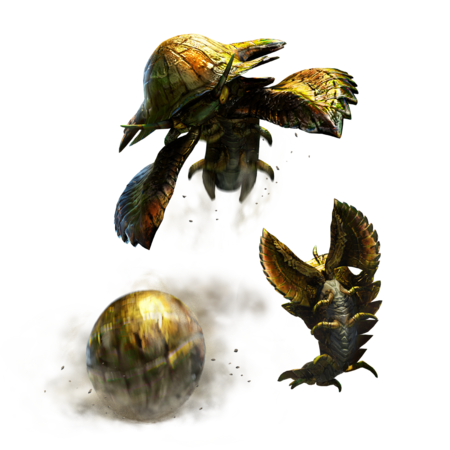
That’s it for this week’s blog. Thanks for reading, and get ready to start hunting!
-
Brands:Tags:
-

Loading...
Platforms:
